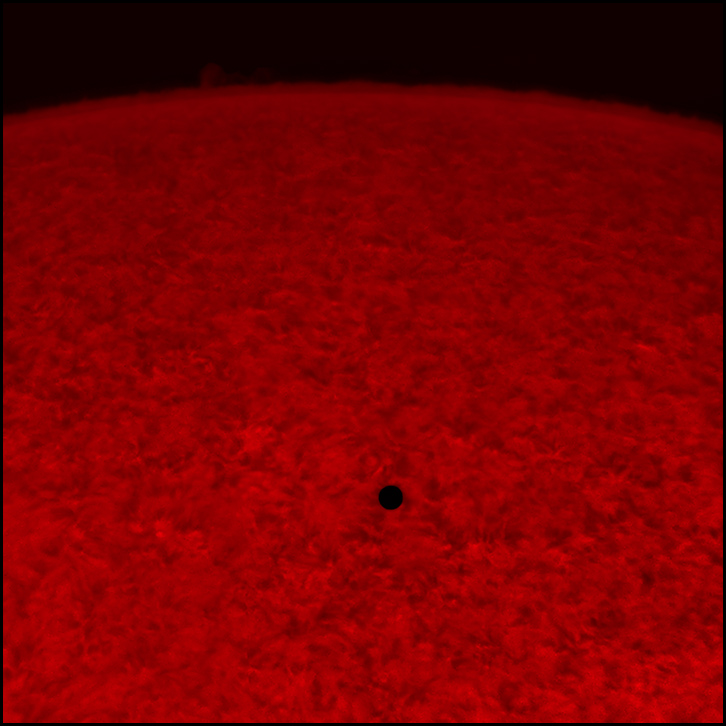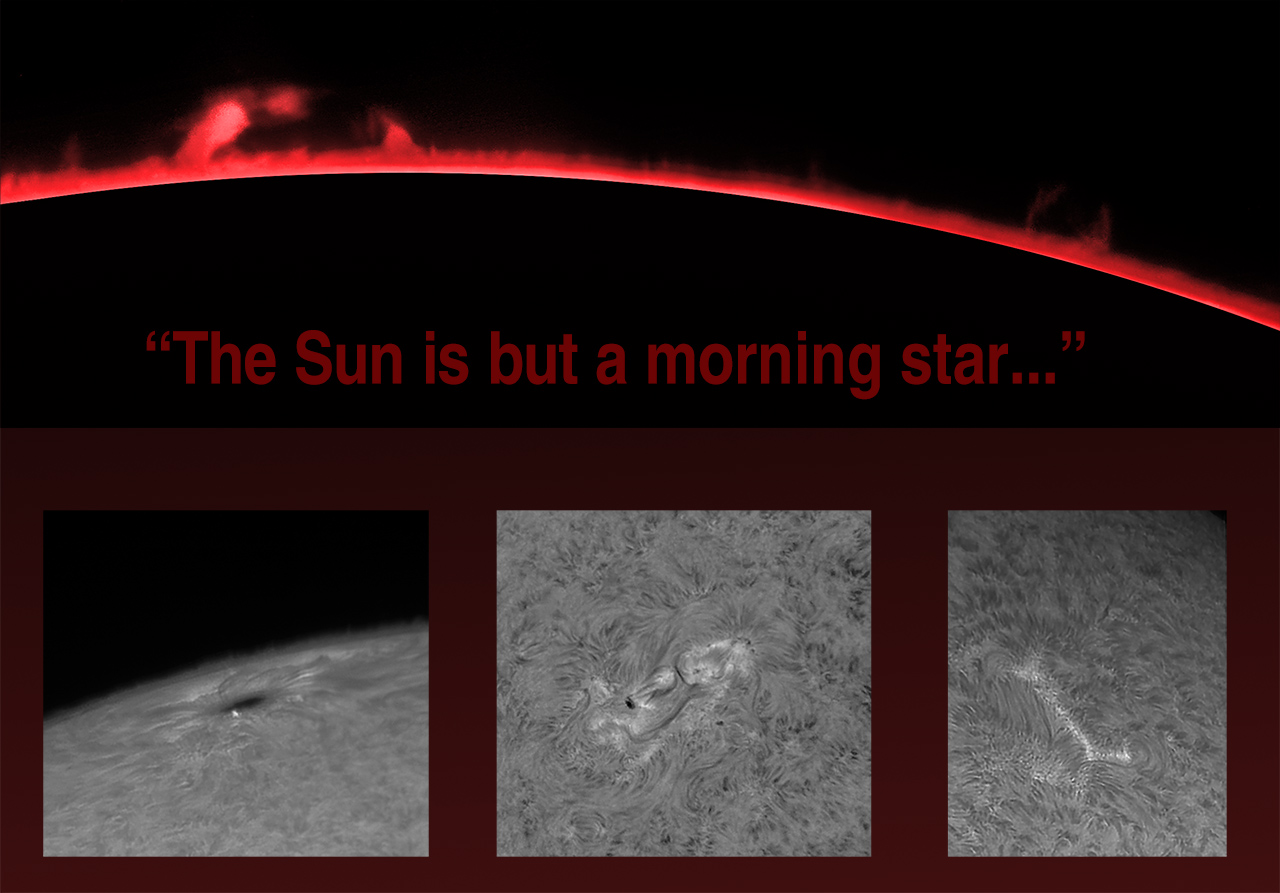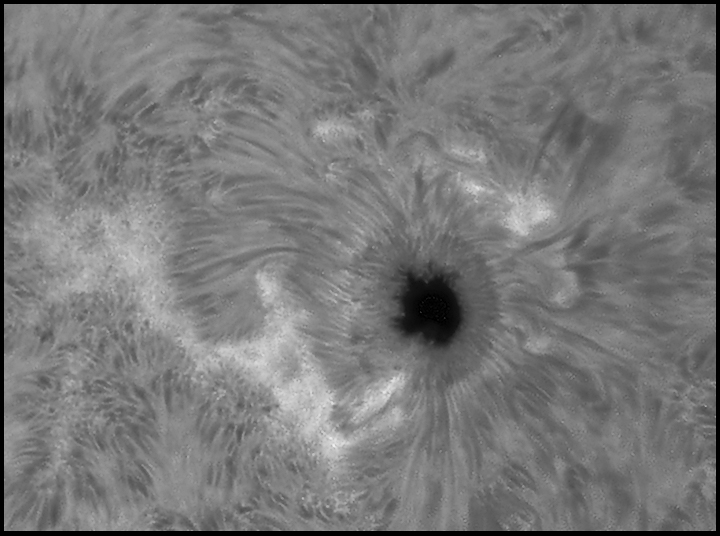Transit of Mercury
05/9/2016. The forecast was not good. I got up anyway. I'd scouted out locations for shooting the Sun at low elevations just in case the weather was good early. It was. "Mostly cloudy," and "overcast" kept appearing in the forecast for midday and beyond, so if I saw sunlight in the trees, I wanted to go straight to a spot where it hit the ground rather than waiting for the Sun to clear the pines.

Waiting for clearish spells at the east end of Rivercliff Drive
I pushed the 90mm Orion achromat / Lunt 60THa Frankenscope to the Sun, cranked both gain and exposure time on the ZWO video camera, focused, lucked into the right quadrant of the Sun — the one containing the planet Mercury in silhouette — without hunting, grabbed some "insurance" video just in case the sky closed down sooner than expected, re-aimed at the center of the Sun, de-focused, took a flat, re-focused, and slewed back to Mercury. Practice helps. And then I settled down with morning coffee in a thermos to wait for clear and steady intervals. When they came, I still had to use longish exposures (17ms vs the usual 6) and more gain than I wanted (about 60 units --I don't think those are db-- rather than 35-40), but given the dismal forecast, who's complaining? All that had taken about five busy minutes. By and by, I got several clips to work with. I concentrated on getting a widefield mosaic of 4-6 frames. Soon, clouds moved in for real. I'd spent 45 minutes staring at the Sun, and I had 15GB of data in hand. Rather than wait to collect more, I packed up and headed down the hill.
Here's the best of the take (so far):

Click the picture for a better view.
Or click here for the uncolorized, b/w version.
Those are six-panel mosaics built from 500-frame clips. I used the best 50 frames from each. Noise-reduced, deconvolved, saved as 16-bit Tiffs, opened with identical profiles in Photoshop, assembled, and then range-stretched to keep limb detail. Note that I enabled 4 wavelet layers for deconvolution (accepting defaults for noise parms), used a relatively large StdDev (2.3) and small Shape (1.05), and repeated applications of 15-iterations of Richardson-Lucy deconvolution until noise became apparent. Then I backed off one stage and applied a pass of TGVDenoise (5/2/2/100) which allowed an additional deconvolution pass. It really is a piece of cake with a fast computer (see previous page!) and lots of practice (see previous 47 years).
Photographers Beware!
Your judgement may differ, but this did not seem like a good idea to me. Yesterday morning, I got a call from a photo researcher in the UK asking for transit photos. He'd seen my NASA APOD from the day before. Sure, I'd send some along, and I did. I was under the impression (maybe my bad) that the gentleman was looking for something specific for a particular use. Today I got a proposed contract which, if signed, would grant exclusive worldwide rights in perpetuity to anything I submitted to a media sharing / stock / microstock pool. The contract granted to Caters News Agency / Clipservers exclusive rights to use and to distribute anything submitted, including derivative works, on all media present and future. Supposedly, I'd get 60% of sales, but I couldn't use, distribute, or otherwise market any of the images (or any substantially similar ones) anywhere. Except maybe on Mars or the Moon. Thank you. No. I had not signed, will not sign, and requested that the photos I'd sent be removed from their catalog (done, thank you). Then I went out and violated the proposed terms just for good measure by posting the same material on a couple of popular sites. E.g.: Facebook and Spaceweather. And right here on this page, too.
5/14/2016. I am told today is "Astronomy Day." What day isn't? We take our text from the Book of Walden:

click the image for a better look
I finally put the A-P mount on the ETSU-surplus pier (where it was very solid) and used the 90mm Orion achromat and Lunt 60HTa etalon assembly for those. The usual: best 10% of 500 frame clips. The left and right are single clips, the center image is a mosaic of two fields; the rimshot across the top is a mosaic of four.
After shooting this set in commemoration of "Astronomy Day," I carried the solar telescope inside and managed to bounce the ZWO ASI120MM across the floor in the process. It is not behaving well. I considered replacing it with the 178MM model but the after thinking a little about taming another video camera, and of using one that really wants USB3 to work properly, and was going to move ~5x more data at the same bit depth and much more data at full depth, and the headaches of moving that huge files to the desktop and storing them, I elected not to invite hunger for even more new computing machinery. Yeah, I could bin the 178, but would I? Dollars count. So I went with an on-sale replacement of the original camera (Highpoint Scientific).
5/15/2016. I am officially preparing for the 2017 eclipse! I aligned the A-P mount, put the AT65EDQ and Canon 6D on it, and have set it to making 30s unguided exposures of the starfield where the eclipse will occur. Who knows, they might be useful.
5/21/2016. The replacement ASI120MM works great! Highpoint got it to me using their free shipping on Wednesday (I placed my order on Sunday). The new camera has a guide port (will try that out by and by) and an IR-cut filter permanently mounted over the chip (we'll have to see how that works with my near IR filters-- could be very nice, could be a mess). The filter acts as a cover slip for the chip, so dust is not as sharp on the image plane. More diffuse dust-spots still flatted out nicely today, but will flats be more vulnerable to changes of focus (they were already dependent on gamma)? Does this camera use the same chip? [yes, evidently] The video clips for this photo were collected using only 5ms exposures with modest gain. That seems like less exposure than was typical using my previous camera. So much for technical arcana. This is the same mighty sunspot that was just rotating into view in last week's image, now facing the Earth.

AR 2546
Best 400 of 2000 frames.
FireCapture, AVIStack2, Pixinsight, Photoshop. In that order.
Note one: Finally, a hint of those tones that I have never managed to get in my solar imaging. Use lots of frames. Next time, take a dark frame, too. I think hot pixels matter even in 5ms exposures when the chip is 103°F. That would explain why fine "dots" appear in aggressively deconvolved images. This is a good enough and long enough clip that I can do meaningful comparisons of images constructed from, for example, 10, 50, 150 and 400 frame subsets: Yowzer! 150 is OK, 400 is better, 10 is hopeless, and my usual 50 is almost certainly too few. Reconsider the balance between using only images made through the best seeing and knocking down electronic noise through image-count. I say that because using 150/500 is almost (almost!) as effective as 150/2000. 600/4000 would be interesting.
Note two: to get that lovely brilliant yellow/orange fading to red/black palette, set the RGB levels thisaway: R(1.6), G(0.6), B(0.2) then adjust the overall RGB slider as needed. These levels are saved as the "solar_chat.alv" preset in my Photoshop "levels" dialog. (Afterwards, applying similar settings as a second pass can produce some dramatic effects as can very small adjustments of the "Hue" slider under Saturation.)
Note three: if you still get a case of the white speckles after a sharpening pass in Photoshop, try the "fade" dialog after selecting "darken."
Note four: Registax is a different animal with this much processing power! As much as I love Pixinsight, as good as it is under the night sky, Registax may be largely taking over for solar work. More soon.
And finally: yes, I do know this page needs to be moved into the "Staring at the Sun" section. With a killer colorized image, too. All in good time.